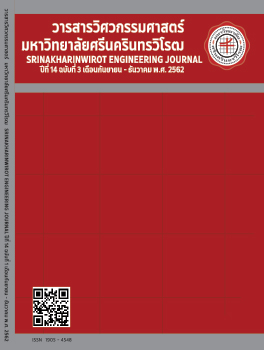Instability Mitigation of a Three-Phase Diode Rectifier Feeding a Controlled Buck Converter by Using Feedforward Loop
Main Article Content
Abstract
This paper presents the instability mitigation of AC-DC power system feeding a controlled buck converter by using a feedforward loop. Power converters with their controls normally behave as constant power loads (CPLs). These CPLs have negative resistance which may cause system instability. Therefore, it is essential to study the instability mitigation technique for improving the system stability. The dynamic model derived from the DQ method and the generalized state-space averaging method (GSSA) is used with the eigenvalue theorem for the stability analysis. The proposed instability mitigation is verified by the intensive time-domain in MATLAB. The results show that the proposed instability mitigation in article is consistent with the stability analysis in theorem. In addition, the unstable system due to a constant power load can become back to the stable operation using the proposed technique.
Article Details
Copyright belongs to Srinakharinwirot University Engineering Journal
References
[2] A. M. Rahimi and A. Emadi, “An analytical investigation of DC/DC power electronic converters with constant power loads in vehicular power systems,” IEEE Trans. Veh. Technol., vol. 58, no. 6, pp. 2689-2702, Jul. 2009.
[3] U. Ghisla, I. Kondratiev and R. Dougal, “Protection of medium voltage DC power systems against ground faults and negative incremental impedances,” in IEEE SoutheastCon 2010, Concord, NC, 2010, pp. 259–263.
[4] K-N. Areerak, S.V. Bozhko, G.M. Asher and D.W.P. Thomas, “Stability analysis and modelling of AC-DC system with mixed load using DQ-transformation method,” in 2008 IEEE International Symposium on Industrial Electronics, Cambridge, UK, 2008, pp. 19-24.
[5] A. Baghramian and A.J. Forsyth, “Averaged-value models of twelve-pulse rectifiers for aerospace applications,” in Second International on Power Electronics, Machines and Drives, Edinburgh, UK, 2004, pp. 220–225.
[6] J. Mahdavi, A. Emadi, M.D. Bellar and M. Ehsani, “Analysis of power electronic converters using the generalized state-space averaging approach,” IEEE Trans. Circuits Syst. I, Fundam. Theory Appl., vol. 44, no. 8, pp. 767-770, Aug. 1997.
[7] T. Sopapirm, K-N. Areerak and K-L. Areerak, “Stability analysis of AC distribution system with six-pulse diode rectifier and multi-converter power electronic loads,” Int. Rev. Elect. Eng., vol. 6, no. 7, pp. 2919-2928, Nov./Dec. 2011.
[8] K-N. Areerak, S.V. Bozhko, G.M. Asher, L. De lillo and D. W. P. Thomas, “Stability study for a hybrid AC-DC more-electric aircraft power system,” IEEE Trans. Aerosp. Electron. Syst., vol. 48 no. 1, pp. 329-347, Jan. 2012.
[9] M. Cespedes, L. Xing and J. Sun, “Constant-power loads system stabilization by passive damping,” IEEE Trans. Power Electron., vol. 26, no. 7, pp. 1832-1836, Jul. 2011.
[10] X. Liu and S. Ma, “Large signal stabilization method of constant power loads by adding R parallel damping filters,” in 2015 IEEE Energy Conversion Congress and Exposition, Montreal, QC, 2015, pp. 1314–1319.
[11] A.M. Rahimi and A. Emadi, “Active damping in DC/DC power electronic converters: a novel method to overcome the problems of constant power loads,” IEEE Trans. Ind. Electron., vol. 56, no. 5, pp. 1428-1439, Feb. 2009.
[12] A.M. Rahimi, G.A. Williamson and A. Emadi, “Loop-cancellation technique: a novel nonlinear feedback to overcome the destabilizing effect of constant-power loads,” IEEE Trans. Veh. Technol., vol. 59, no. 2, pp. 650-661, Feb. 2010.
[13] Y. Li, K.R. Vannorsdel, A.J. Zirger, M. Norris and D. Maksimovic, “Current mod control for boost converters with constant power loads,” IEEE Trans. Circuits Syst. I, Reg. Papers, vol. 59, no. 1, pp. 198-206, Jan. 2012.
[14] Y. Zhao, W. Qiao and D. Ha, “A sliding-mode duty-ratio controller for DC/DC buck converters with constant power loads,” IEEE Trans. Ind. Appl., vol. 50, no. 2, pp. 1448–1458, Mar./Apr. 2014.
[15] M. Wu and D. D. Lu, “A novel stabilization method of LC input filter with constant power loads without load performance compromise in dc microgrid,” IEEE Trans. Ind. Electron., vol. 62, no. 7, pp. 4552-4562, Jul. 2015.
[16] T. Sopapirm, K-N. Areerak and K-L. Areerak, “The active damping stabilization of AC-DC power systems feeding constant power loads,” Int. Rev. Elect. Eng., vol. 12, no. 4, pp. 287-295., Jul./Aug. 2017.
[17] K-N. Areerak, T. Sopapirm, S.V. Bozhko, C. I. Hill, A. Suyapan and K-L. Areerak, “Adaptive stabilization of uncontrolled rectifier based AC-DC power systems feeding constant power loads,” IEEE Trans. Power Electron., vol. 33, no. 10, pp. 8927-8935, Oct. 2018.
[18] X. Liu, A. Forsyth, and A. Cross, “Negative input-resistance compensator for a constant power load,” IEEE Trans. Ind. Electron., vol. 54, no. 6, pp. 3188–3196, Dec. 2007.
[19] P. Magne, D. Marx, B. Nahid-Mobarakeh and S. Pierfederici, “Large-signal stabilization of a dc-link supplying a constant power load using a virtual capacitor: impact on the domain of attraction,” IEEE Trans. Ind. Appl., vol. 48, no. 3, pp. 878-887, May/June 2012.
[20] Y.R. Mohamed, A.A.A. Radwan and T. Lee, “Decoupled reference voltage-based active dc-link stabilization for pmsm drives with tight-speed regulation,” IEEE Trans. Ind. Electron., vol. 59, no. 12, pp.4523- 4536, Dec. 2012.
[21] M. Wu and D. D. C. Lu, “Investigation on active method for stabilization of LC input filter and DC/DC buck converter under voltage mode control,” in 2015 IEEE 11th International Conference on Power Electronics and Drive Systems, Sydney, NSW, 2015, pp. 721–726.
[22] M. Wu an, D. D. C. Lu and C.K. Tse, “Direct and optimal linear active methods for stabilization of LC input filters and DC/DC converters under voltage mode control,” IEEE J. Emerg. Sel. Top. Circuits Syst., vol. 5, no. 3, pp. 402-412, Sep. 2015.
[23] T. Sopapirm, “Instability mitigation of a three-phase diode rectifier feeding a controlled buck converter by using the active damping method,” in 2018 21st International Conference on Electrical Machines and Systems, Jeju, 2018, pp. 745–748.


